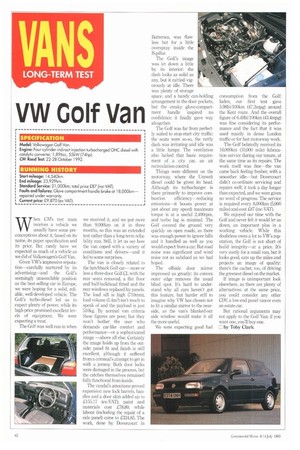vw Golf van W hen CMs test team receives a vehicle
Page 44

If you've noticed an error in this article please click here to report it so we can fix it.
we usually have some preconceptions about it, based on its name, its paper specification and its price. But rarely have we expected as much of a vehicle as we did of Volkswagen's Golf Van,
Given VVv''s impressive reputation—carefully nurtured by its advertising—and the Golfs seemingly unassailable position as the best-selling car in Europe, we were hoping for a solid, reliable, well-developed vehicle. The Golf's turbo-diesel led us to expect plenty of power, while its high price promised excellent levels of equipment. We were expecting a treat.
The Golf was well run-in when we received it, and we put more than 9,000km on it in three months, so this was an extended test rather than a long-term reliability run. Still, it let us see how the van coped with a variety of conditions and drivers—and it led to some surprises.
The van is closely related to the hatchback Golf car— more or less a three-door Golf CL with the rear seats removed, a flat floor and half-bulkhead fitted and the rear windows replaced by panels. The load sill is high (710mm), load volume (1.4m3) isn't much to speak of and the payload is just 510kg. By normal van criteria these figures are poor, but they won't bother the user who demands car-like comfort and performance—or a sophisticated image —above all else. Certainly the image holds up from the outside: panel fit and finish is still excellent, although it suffered from a criminal's attempt to get in with a jemmy Both door locks were damaged in the process, but the catches themselves remained fully functional from inside.
The vandal's attentions proved expensive: new lock barrels, handles and a door skin added up ti £155.17 (ex-VAT); paint and materials cost £78.80, while labour (including the repair of a side panel) came to L334.85. The work, done by Dovercourt in Battersea, was flawless but for a little overspray inside the B-pillar.
The Golfs image was let down a little by its interior: the dash looks as solid as any, but it rattled vigorously at idle. There was plenty of storage space, and a handy can-holding arrangement in the door pockets, hut the creaky glove-compartment handle inspired no confidence: it finally gave way altogether.
The Golf was far from perfectly suited to stop-start city traffic: the seats were so-so, the rattly dash was irritating and idle was a little lumpy. The ventilation also lacked that basic requirement of a city car, an air recirculation control.
Things were different on the motorway, where the Umwelt diesel could be given its head. Although its turbocharger is there primarily to improve com bustion efficiency—reducing emissions—it boosts power at just about any speed; maximum torque is at a useful 2,400rpm, and turbo lag is minimal. The Golf covered the ground very quickly on open roads, as there was enough power to ignore hills and it handled as well as you would expect from a car. But road noise was significant and wind noise not as subdued as we had hoped.
The offside door mirror impressed us greatly: its convex outer edge removes the usual blind spot. It's hard to understand why all cars haven't got this feature, but harder still to imagine why VW has chosen not to fit a similar mirror to the nearside, as the van's blanked-out side window would make it all the more useful.
We were expecting good fuel consumption from the Golf: laden, our first test gave 5.981it/100km (47.2mpg) around the Kent route. And the overall figure of 6.491ft/100km (43.4mpg) was fine considering its performance and the fact that it was used mainly in dense London traffic or for fast motorway work.
The Golf belatedly received its 16,000km (10,000 mile) lubrication service during our tenure, at the same time as its repairs. The work itself was fine—the van came back feeling fresher, with a smoother idle—but Dovercourt didn't co-ordinate servicing and repairs well: it took a day longer than expected, and we were given no word of progress. The service is required every 8,000km (5,000 miles) and cost £87 (inc-VAT).
We enjoyed our time with the Golf and never felt it would let us down, an important plus in a working vehicle. While this doubtless owes a lot to VW 's reputation, the Golf is not short of build integrity—at a price. It's very costly for a small van, but it looks good, eats up the miles and projects an image of quality: there's the cachet, too, of driving the greenest diesel on the market.
If image is unimportant look elsewhere, as there are plenty of alternatives: at the same price, you could consider any other CDV, a low-end panel van-or even an estate car.
But rational arguments may not apply to the Golf Van: if you want one, you'll buy one.
E by Toby Clark




















































































